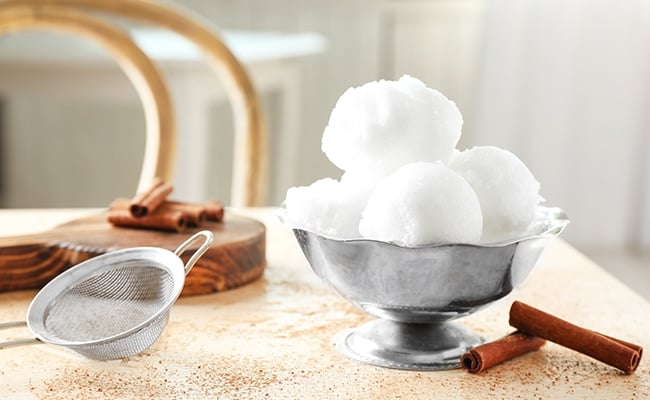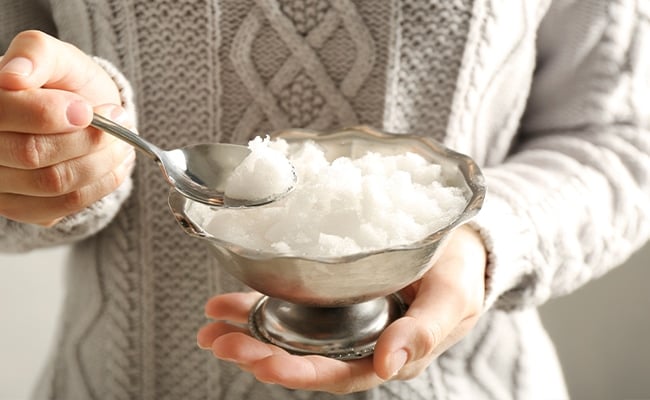How To Make Snow Ice Cream — A Sweet Celebration!

Snow ice cream (or snow cream, depending on who you ask) is a special treat that many adults today associate with fond childhood memories. You may be surprised to learn that the origin of this delightful dessert goes back several centuries. Here are some fun facts about its longstanding history as well as a snow ice cream recipe so you can give it a try!
The History Of Snow Ice Cream
Snow’s association with dessert dates back to 2700 BCE, when it is believed to have been combined with cooked fruit. Persian cuisine around 500 BC featured snow-and-honey desserts. Evidence or stories of snow-based desserts can be found in Ancient Rome, North America, and even China. The last one is theorized to have inspired Venetian gelato, through Marco Polo. The early history of ice cream has retained its roots in what some call the epitome of Southern comfort food: snow (ice) cream.
Is Snow Ice Cream A Southern Treat?
Despite the author’s best efforts, no exact reason or history could be found as to how snow ice cream became a popular Southern treat. However, a wide range of Southerns agree that this was a special winter celebration in their upbringings.
The tradition is so ingrained in the area that Mayfield Ice Cream, produced in Tennessee, started selling an ice cream flavor in the early 90s replicating the light, icy vanilla of snow cream. The flavor was named appropriately: Snow Cream Ice Cream. They still sell it today as an expanded line of products.
How To Make Snow Ice Cream
The Southern treat, which ever name you prefer, basically has four ingredients and a very straight forward recipe.
For a modern snow ice cream recipe, you’ll need a form of milk, sweetener, vanilla, and of course: snow. (Older recipes included raw egg, but that raises some food safety concerns.)
Some recipes call for boiling milk and sugar before chilling it well and mixing with snow. Others save time and effort by using evaporated or condensed milk.

All people seem to agree that the milk mixture and snow need to be mixed lightly (until it is the consistency of a thick milkshake) and then eaten immediately. (Note: Snow ice cream doesn’t like the freezer much.)
Variations On Southern Snow Cream
This recipe is nicely malleable, it can be rearranged to suit a range of dietary needs.
- Vegetarian/vegan: almond, oat, rice, or coconut milk can all be used instead of dairy milk.
- Sugar-free: any sweetener you’d use for baking or cooking could be substituted. Besides, the Canadians already have fond things to say about maple syrup + snow. (If you’re using xylitol, plan on heating the milk first. Xylitol melts better than it dissolves.)
- Even time of year can be accounted for. Say you get a hankering for snow ice cream in the middle of summer: shaved ice may be substituted for the snow itself.
Mix-Ins For Snow Ice Cream
Now, why stop once you’ve got the base recipe adjusted perfectly? Next comes the mix-ins, but move fast: remember snow ice cream melts swiftly.
- Cocoa powder: chocolate anyone!?
- Powdered freeze-dried strawberries: might as well gather the holy Neapolitan of ice cream flavors!
- Sprinkles: what’s not to love? (The colors can start running when exposed to the more watery constitution of snow cream, so be aware!)
- And for the children-at-heart who are 21+: a dash of rum or limoncello.
Is It Safe to Eat Snow?
It depends. The age-old adage still holds true: don’t eat the yellow snow. Disturbed snow in general—plowed, salted, driven over, etc.—is best left alone.
Above and beyond that, snow acts as an atmospheric cleaner as it falls. The lattice structures of snowflakes catch pollutants and ground them. While that’s great for the air, it also means that especially the first few hours of a snowfall are well-laced with unpleasant chemicals:
- Sulfates
- Nitrates
- Formaldehyde
- Mercury
- DDT
- Black carbon (soot)
That said, after the first few hours, snow generally contains fewer contaminants than the definition for safe drinking water. According to NPR, a range of snow researchers confirmed they would still eat snow. (One even noted how well fresh Alaskan snow pairs with malt whiskey … another tip for the 21+ crowd?)
The end result: let it snow a few hours while the anticipation builds and then set out a bowl to collect your titular ingredient to enjoy snow ice cream, a grand Southern tradition of celebrating the winter wonderland.
Join The Discussion
Will you try our snow ice cream recipe?
Do you have any suggestions to add?
Share your memories and thoughts in the comments below!

Elora Holt
Elora Holt is a writer and researcher based in Washington state. Her favorite topics revolve around digging up peculiar historical information—from uses of pig bladders to why glass went clear in the 1930s. Elora also writes for RevisitingHistory.com and Latino Alternative Television (LATV).



Nobody should be doing this at all! The toxins that are in the snow are not the same as it was years ago, it’s now so polluted! Please only make this with shaved ice from filtered water.
will try this recipe when it snows. I live in tennessee so waiting paitently for snow! also saw a post about persimmon seeds and this year its the symbol for lots of snow: a spoon.
Sounds like you might have a lot of snow to make ice cream!
Never had snow ice cream but heard a lot about it.on the farmers almanac website I saw a post about snow being toxic to humans? how do you know if you will or will not get sick?
My Mother made us snow ice cream in late 50 an 60’s. . she would put it in freezer for a bit than bring it out an mix good would be like a slushy ice cream. Oh how good it was.